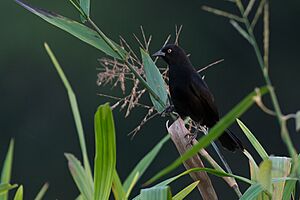Pale-eyed blackbird facts for kids
Quick facts for kids Pale-eyed blackbird |
|
|---|---|
 |
|
| Conservation status | |
| Scientific classification | |
| Genus: |
Agelasticus
|
| Species: |
xanthophthalmus
|
 |
|
The pale-eyed blackbird (Agelasticus xanthophthalmus) is a cool bird that belongs to the Icteridae family. You can find it living in Ecuador and Peru. This bird loves to hang out in wet places like swamps. It's a bit shy and not often seen, but it was first discovered in 1969.
Contents
What Does the Pale-Eyed Blackbird Look Like?
Adult pale-eyed blackbirds are completely black. Both male and female birds look the same. They have very special eyes with white or pale yellow-brown irises. This eye color helps tell them apart from other black birds in their area. For example, the velvet-fronted grackle and the shiny cowbird have dark eyes.
Younger pale-eyed blackbirds look a bit different. They are brownish-black. Their chests and bellies have streaks of yellow or pale yellow-brown.
What Does It Sound Like?
The pale-eyed blackbird has a loud and clear call. It sounds like a metallic "tew-tew-tew-tew." This call is similar to the sound made by a black-capped donacobius. You can often hear the pale-eyed blackbird singing from the top of a bush.
Where Does the Pale-Eyed Blackbird Live?
This blackbird lives in a small part of eastern Peru and Ecuador. Its favorite places are marshy areas around lagoons and oxbow lakes. It also likes the edges of nearby grasslands.
Since it was first found in 1969, people have seen it regularly. It lives in the Limoncocha National Biological Reserve near the Napo River in Ecuador. It's also found in the Tambopata National Reserve near the Madre de Dios River in Peru.
How Does the Pale-Eyed Blackbird Behave?
You will usually see pale-eyed blackbirds in pairs. They spend most of their day in marshy spots. They like to hide in thick bushes and plants.
These birds are easiest to spot in the early morning. That's when they come out into more open areas to find food. This is also the best time to hear them singing from the top of a bush.
Is the Pale-Eyed Blackbird Endangered?
The pale-eyed blackbird lives in a small area. However, there are more than 10,000 adult birds. Their numbers seem to be steady, and they don't face many big dangers right now.
Because of this, the International Union for Conservation of Nature has listed it as a "least concern" species. This means it is not currently at risk of disappearing.


